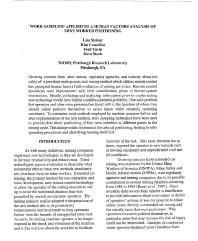Mining Publication: Work Sampling Applied to a Human Factors Analysis of Mine Worker Positioning
Original creation date: October 1998
Authors: LJ Steiner, KM Cornelius, FC Turin, D Stock
NIOSHTIC2 Number: 20000136
Proc Human Factors and Ergonomics Society 42nd Annual Meeting, Vol 2, 1998 Oct; :1103-1107
Growing concern from labor unions, regulatory agencies, and industry about the safety of a prevalent underground coal mining method which utilizes remote control has prompted human factors field evaluation of mining activities. Remote control operations were implemented with little consideration given to human-system interactions. Ideally, collecting and analyzing information prior to implementing new technology would have helped to address potential problems. One such problem that operators and other mine personnel are faced with is the question of where they should safely position themselves to avoid injury while remotely operating machinery. To determine work methods employed by machine operators before and after implementation of the new method, work sampling techniques have been used to provide data about positioning of face crew members at different points in the mining cycle. This data provides information for optimal positioning, leading to safer operating procedures and identifying training shortfalls.

NIOSHTIC2 Number: 20000136
Proc Human Factors and Ergonomics Society 42nd Annual Meeting, Vol 2, 1998 Oct; :1103-1107
- Diagnosing and Controlling Moisture-Sensitive Roof in Coal Mines
- Progress Toward Improved Engineering of Seals and Sealed Areas of Coal Mines
- Refuge Alternatives in Underground Coal Mines
- Rock Dusting Considerations in Underground Coal Mines
- Safe and Economical Inerting of Sealed Mine Areas
- SPONCOM - A Computer Program for the Prediction of the Spontaneous Combustion Potential of an Underground Coal Mine
- Technology News 535 - NIOSH Releases New Educational Video: Escape from Farmington No. 9: An Oral History
- Technology News 545 - NIOSH Updates Spontaneous Combustion Assessment Software
- Ultra-Low Frequency Through-the-Earth Communication Technology
- Wireless Mesh Mine Communication System